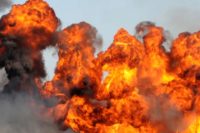Things have gotten pretty bad in Washington, DC when OSHA adopts a new rule which makes its enforcement job harder and whose only beneficiary is the global chemical industry.
Until 2012, OSHA had a rule which required that a cancer warning label be placed on a chemical if it appeared on a national or international list of cancer causing chemicals. The rule was clear, simple and easy to enforce. It was not even controversial.
But it is no longer in effect.
Now OSHA has taken on the burden of proving, on a chemical by chemical basis, whether a chemical can cause cancer. To make matters worse (and drive that knife into its back even harder), OSHA adopted a criteria for determining carcinogenicity that can be used by chemical companies to sow doubt and uncertainty about a chemical’s ability to cause cancer in human beings.
All of this occurred while OSHA is being run by Assistant Secretary of Labor David Michaels, who wrote the book on the chemical industry’s ability to sow doubt and manufacture uncertainty, Doubt Is Their Product–How Industry’s Assault on Science Threatens Your Health, Oxford University Press, 2008.
In the book, published the year before he took over the helm at OSHA, Dr. Michaels chronicled how the chemical industry will spend whatever it takes to produce skewed studies in order to handcuff agencies such as OSHA from effectively protecting worker health.
Beginning in the 1970s, the categorization of toxic chemicals into classes which can cause cancer evolved into a highly sophisticated system of scientific review by the leading experts in the field.
At the international level, this effort is led by the World Health Organization’s International Agency for Research on Cancer (IARC), headquartered in Lyon, France.
In the United States, the National Toxicology Program (NTP) of the US Department of Health and Human Services produces the Report on Carcinogens.
As a result of the work of these agencies, when a chemical ends up on their lists as either carcinogenic to humans or known to be a human carcinogen, one knows that the evidence for and against such classifications has been repeatedly reviewed by some of the best and brightest scientific minds.
From 1985 until 2012, OSHA required manufacturers and employers to label chemicals as carcinogens (cancer causing) if they appeared on the NTP or IARC lists. That rule, which was part of the Hazard Communication Standard, made sense for a number of reasons. First and foremost, OSHA, in its 43 years of existence, has only issued cancer standards for 25 chemicals or substances.
By comparison, the NTP’s 12th Report on Carcinogens, issued in 2011, lists 54 substances as "known to be human carcinogens" and 186 substances as "reasonably anticipated to be human carcinogens."IARC currently lists 113 agents in its most severe category, Group 1, as "carcinogenic to humans." IARC also lists 66 agents in Group 2A, "probably carcinogenic to humans," and 285 agents in Group 2B, "possibly carcinogenic to humans." If a chemical appeared on any of these lists, it had to labeled as a carcinogen under the Hazard Communication Standard.
But in 2012, OSHA decided to toss this entire system overboard and return to the olden days when these disputes were settled not by the quality of the evidence, but by the number of gunslingers one could hire.
Under OSHA’s new "globally harmonized system" of hazard communication, a chemical manufacturer can dispute the science on which a cancer designation had been based. When these disputes arise, OSHA, not the manufacturer, bears the burden of proof. The agency will always be outgunned by the global chemical industry and worker protection will suffer. Inexplicably, this wound was completely self-inflicted. No one demanded or petitioned OSHA to make this change.
Under the Hazard Communication Standard in effect from 1985 to 2012, the decision whether or not to label a chemical as cancer causing was a model of simplicity. If it appeared on the IARC or NTP lists, it had to be labeled as cancer causing. So when an OSHA compliance officer was performing a workplace inspection, he or she only needed to cross check the IARC or NTP lists in order to determine whether a chemical should have been labeled as cancer causing.
If the compliance officer found a violation, the citation could easily be proven before the Occupational Safety and Health Review Commission, a separate agency which adjudicates appeals of OSHA enforcement actions. To prove up the violation, OSHA would put the compliance officer on the witness stand with the IARC or NTP list in his or her hand and marked as an exhibit.
Today, OSHA will need to hire a panel of expert scientists to prove up the same violation. The new "globally harmonized hazard communication standard" permits a chemical manufacturer or an employer to cite a multiplicity of factors for not deeming a chemical to be a carcinogen.
These factors are split into two categories. Under "strength of evidence," the statistical significance of the tumors found in animal and human studies can be debated. Under "weight of evidence," the full list of relevant factors was so lengthy that OSHA couldn’t even list all of them in the standard. Rather, OSHA specified the following 11 factors, which it believed to be important:
(a) tumor type and background incidence
(b) multisite responses;
(c) progression of lesions to malignancy;
(d) reduced tumor latency;
(e) whether responses are in single or both sexes;
(f) whether responses are in a single species or several species;
(g) structural similarity or not to a substance(s) for which there is good evidence of carcinogenicity;
(h) routes of exposure;
(i) comparison of absorption, distribution, metabolism and excretion between test animals and humans;
(j) the possibility of a confounding effect of excessive toxicity at test doses; and,
(k) mode of action and its relevance for humans, such as mutagenicity, cytotoxicity with growth stimulation, mitogenesis, immunosuppression.
If your eyes are glazing over, then I have made my point. A simple and understandable system has been replaced by a requirement to conduct a full-blown scientific review of every kernel of evidence for and against carcinogenicity.
OSHA will need to convene a team of epidemiologists, toxicologists, physicians, chemists, and human and animal pathologists in order to prove up every case. The expense and burden of this new requirement will overwhelm this thinly staffed agency.
In this era of tightened Federal domestic spending, the likelihood of OSHA mounting such an effort every time a manufacturer or employer decides to fight a cancer designation is little to none.
The complexity of cancer classification of chemicals is best illustrated by the process followed by the NTP. The Federal budget contains more than $100 million every year to support the NTP in its scientific reviews of the evidence of chemical carcinogenicity.
For that money, the NTP follows a detailed, excruciating, and lengthy multi-step process in order to list a substance in the Report on Carcinogens. I have had first-hand experience with this process in my effort to have ortho-toluidine recognized as a proven human bladder carcinogen.
On March 20, 1999, I wrote to the NTP and nominated ortho-toluidine for its most severe category, "known to be a human carcinogen." The chemical had been listed since 1983 as "reasonably anticipated to be a human carcinogen," a classification which did not take into account the study of the Goodyear workers published by Dr. Elizabeth Ward of NIOSH in 1991.
Nothing happened with my request for more than 12 years until January 19, 2012, when the NTP published a notice in the Federal Register requesting public comment on reclassifying ortho-toluidine in the next (the 13th) Report on Carcinogens. In 2008, the IARC had cut a trail for the NTP to follow when it declared ortho-toluidine to be "carcinogenic to humans" and classified it as an IARC Group 1 carcinogen.
In 2013, NTP issued a draft monograph in support of reclassifying ortho-toluidine to "known to be a human carcinogen." This 232-page report was the most comprehensive summary of the evidence of ortho-toluidine’s carcinogenicity which has ever been written. Its publication engendered no industry comments or criticisms. NTP has since conducted a public peer-review of the monograph. The NTP panel of experts voted unanimously to recommend that ortho-toluidine be classified as a "known human urinary bladder carcinogen."
But the NTP review and evaluation process is not yet over. By my count, ortho-toluidine still has another five sets of reviews to go in a 22-step process before its new listing is published in the Report on Carcinogens.
Yet, OSHA threw this deliberative process overboard when it adopted the "globally harmonized hazard communication standard" in 2012. Now OSHA has to go it alone.
Why did this happen? I don’t pretend to have the answer, but there are some red flags flying which warrant further investigation.
While the labor movement initially stumbled when it first considered the issue, it ultimately reached the right position, a fact ignored by OSHA. In its initial comments to OSHA on December 29, 2009, the United Steelworkers acquiesced to the concept that the new rule would do away with mandatory adherence to the IARC and NTP lists.
But by June 1, 2010, in its final post-hearing comments, the United Steelworkers realized the difficulties which would ensue when OSHA would attempt to cite an employer or manufacturer for a faulty "weight of the evidence" cancer determination. The Steelworkers asserted that: the final standard should also state that if a chemical has been determined to be carcinogenic by IARC, the NTP, EPA or NIOSH – all of which are governmental or intergovernmental organizations – OSHA will require it to be labeled as such.
But OSHA ignored the Steelworkers’ change in position and only cited the Union’s 2009 comments in the March 26, 2012 preambleto the final rulemaking.
OSHA’s actions were disingenuous. OSHA’s conclusion in the preamble that the final rule "ensure[s] that the current level of protection in terms of identifying potential carcinogens in the workplace is maintained" remains unsubstantiated.
How did OSHA get to this point?
As a start, the agency needs to re-examine its relationship with the predominant industry organization on the chemical labeling and warnings issue, the Society for Chemical Hazard Communication (SCHC). OSHA has a formal, written "alliance" with the SCHC, which claims to be "a professional society committed to serving chemical hazard communication professionals and to promoting knowledge and awareness in all areas of chemical hazard communication."
Currently, the SCHC president is employed by Monsanto, two board members are employed by 3M, and one board member by Ashland. The chief OSHA staffers who developed the "globally harmonized hazard communication standard" regularly appear and speak at the SCHC’s functions, which cost hundreds of dollars to attend.
Denese Deeds is one of the founding members of the SCHC, and has served as its President, Vice-President, Secretary, Treasurer, and Director and also as a "liaison and committee member" to the SCHC Alliance with OSHA. From 2006 through 2012, Ms. Deeds consulted and testified for DuPont in bladder cancer claims brought against the chemical giant for its failure to provide adequate warnings of the carcinogenicity of its ortho-toluidine. During that time period, Ms. Deeds was paid at least $59,000 by DuPont.
The chief point made by Ms. Deeds in her testimony in these cases was that it was perfectly acceptable for DuPont to omit from its material safety data sheets (MSDS) the fact that bladder cancer was associated with occupational exposure to ortho-toluidine. Even though the original OSHA hazard communication standard required that "statistically significant conclusions regarding the health effects of a chemical "shall be . . . reported on any material safety data sheet," Ms. Deeds testified that DuPont’s MSDSs complied with this OSHA standard and were also "clear and adequate to communicate the hazards of ortho-toluidine."
In short, what happened in this OSHA rulemaking makes no sense, unless you are a chemical manufacturer seeking an opportunity to spread doubt and uncertainty about a cancer designation of one of your products. I’m not the only one who finds OSHA’s actions inexplicable. A UK-based ceramics manufacturer, Morgan Technical Ceramics, came to the same conclusion and told OSHA that:
IARC, NTP and other qualified organizations assess carcinogenicity and come to published conclusions. We do not understand why the proposed Hazard Communication Standard establishes procedures for chemical suppliers to conduct such assessments, seemingly asking them to conduct their own evaluations in the manner of similar to these expert agencies. That makes no sense to us. Why not just refer to the conclusions published by these agencies?
Well said.
For more than forty years, I have been a leader in the field of worker health and safety. In 1969, when I was 19 years old, I investigatedpesticide poisonings of field workers as a volunteer for the United Farm Workers Organizing Committee in Delano, California. That same year, upon Ralph Nader's recommendation, I joined the Washington, DC office of the Oil, Chemical and Atomic Workers International Union (OCAW), where I worked for 12 years under the direction of the “father” of the health and safety movement, Anthony (Tony) Mazzocchi.
At the OCAW, I lobbied Congress for the passage of the Occupational Safety and Health Act (OSHA). After its passage, Mazzocchi and I implemented an aggressive OSHA enforcement program for the OCAW membership. My work included:
- Inspecting plants making beryllium metal, chlorine, dyes, polyvinyl chloride, as well as oil refineries, coke ovens, and numerous chemical plants, including the Pittsburgh Corning plant in Tyler, Texas where Unibestos asbestos pipecovering was manufactured. We brought the National Institute for Occupational Safety and Health (NIOSH) into that plant, where it found that the workers were inhaling some of the highest levels of asbestos dust ever recorded.
- Filing the first complaint under OSHA and obtaining OSHA Citation No. 1, which was issued against Allied Chemical in Moundsville, West Virginia, for overexposing its workers to mercury.
- Representing the Union in hearings before the Occupational Safety and Health Review Commission (OSHRC) where Texaco was contesting OSHA citations which found its workers grossly overexposed to benzene when loading barges and tankers at its Port Arthur, Texas oil refinery.
- Assisting the OCAW local at the Kerr-McGee nuclear fuel fabrication plant near Crescent, Oklahoma in uncovering the plutonium contamination of the plant. Karen Silkwood was one of the leaders of that local union. She was killed when her car was forced off the road on her way to meet with me and David Burnham, a reporter for The New York Times.
- Testifying before committees of the House and Senate on worker safety and health issues on 12 occasions, and serving as a member of the Secretary of Labor’s Standard Advisory Committee on Coke Oven Emissions.
Some of the investigations which Mazzocchi and I conducted for the OCAW have been documented in Expendable Americans by Paul Brodeur, The Viking Press, 1974 (raw asbestos fiber); Muscle and Blood by Rachel Scott, E. P. Dutton & Co. Inc., 1974 (beryllium dust); and the plutonium contamination of the Kerr-McGee plant, in The Killing of Karen Silkwood by Richard Rashke, Houghton Mifflin Co., 1981, and Who Killed Karen Silkwood by Howard Kohn, Summit Books, 1981. A fictionalized version appeared in the movie Silkwood directed by Mike Nichols, 20th Century Fox, 1983.
In 1981, I became a paralegal for attorney Frederick M. Baron, a pioneer of asbestos litigation. While working for Baron, I attended law school at night and graduated in 1986 from Catholic University’s Columbus School of Law in Washington, DC.
While in law school, Vern Jensen, President of OCAW Local 8-891, asked me to investigate the asbestos exposure of his members at the Union Carbide plant in Bound Brook, New Jersey. We were able to document that from 1950 through 1974, Union Carbide had used more than 50 million pounds of raw asbestos fiber in the manufacture of the Bakelite phenolic molding material, which was used in a variety of products, from telephones to automobile parts.
In 1986, I was admitted to the New Jersey Bar and moved here in order to prosecute the asbestos claims from the Union Carbide plant. In 1988, I began my current law practice, Steven H. Wodka, Attorney-At-Law, in Little Silver, New Jersey, where I have specialized in representing workers who have been injured or killed by exposure to toxic chemicals on the job.
"I've been accused of being militant. I think that's a sad reflection of where we are. I thought we would wear proudly the fact that we are militant. I don't intend to bow before any company, an unjust company, an unjust government or tyranny in any form; that's my role to the last breath of my life, that's what trade unionism is about." – Anthony Mazzocchi



